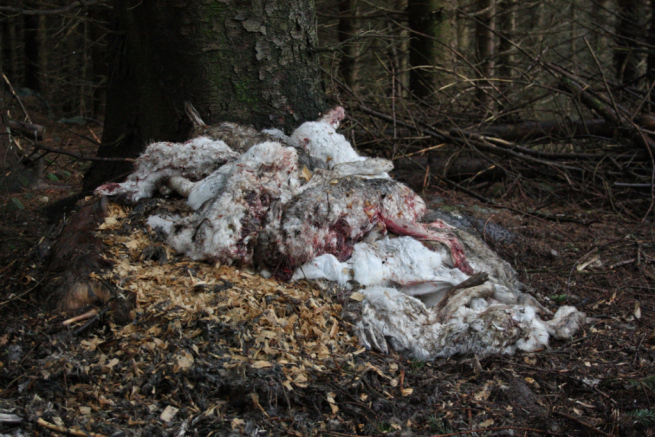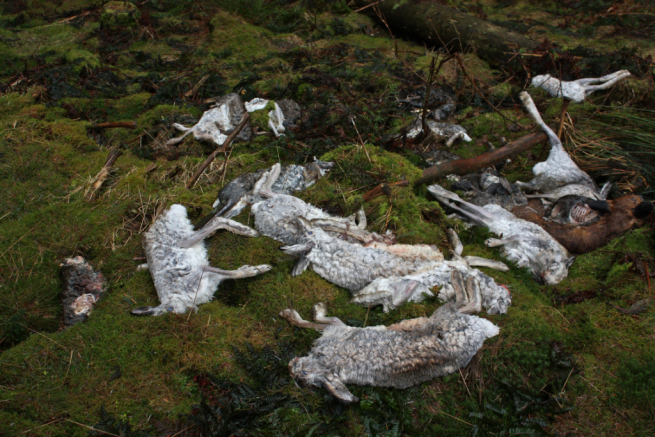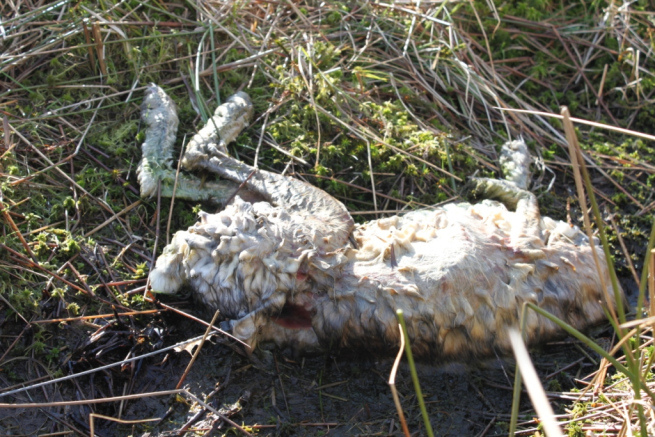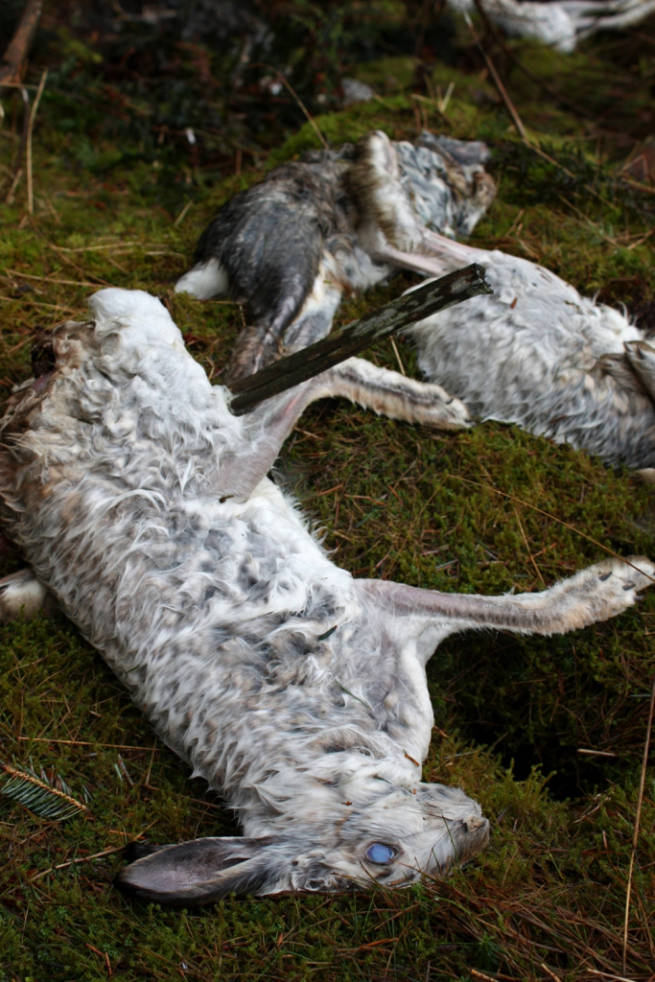Over the last couple of years we’ve blogged a lot about the obscene massacre of mountain hares on Scottish grouse moors (see here for previous posts).
It’s quite the hot topic these days, resulting in Parliamentary questions, public petitions, and even a call from SNH/GWCT/SLE for grouse moor managers to practice “voluntary restraint” – a pointless exercise in our opinion (see here).
It seems that SNH doesn’t have much faith that voluntary restraint will be employed – a few weeks after they issued their plea to landowners, they asked hill-walkers to report any evidence of large-scale culls (see here).
Today, the grouse-shooting industry issued their own press release about mountain hares on grouse moors. We thought it was an early April Fools’ Day stunt but apparently it isn’t. It reads as follows:
MOUNTAIN HARES ON THE MARCH AFTER GROUSE BONANZA
(Issued on behalf of a Scottish Moorland Group)
The Highlands are celebrating a special conservation bonus following two very good grouse seasons.
Scottish moorland managers are reporting large numbers of the much loved and easily recognised mountain hare, linked to last year’s ‘best in a generation’ grouse season. The Scottish population of hares is thought to be around 350,000 and in some areas they are now at historically high levels – the hares have the red grouse to thank!
Concern has been expressed recently that hare numbers may be going down; however grouse moors in the Angus Glens, Speyside and Highlands report that their numbers have increased along with grouse levels. Heather moorland managed for red grouse is an extremely good habitat for hares to thrive on.
The mountain hare is the only native species of hare or rabbit in Britain, easily distinguished by its white plumage during the winter months and brown during the summer. It is known that its population fluctuates in 7-10 year cycles, however actively managed moorlands give this iconic Scottish species a sustainable future.
Danny Lawson, head gamekeeper on Glenogil Estate in the Angus Glens, said: “I have seen more mountain hares this year than at any time since I came here. Our mountain hare population has been increasing along with grouse over the last three years because our heather management gives them good grazing and because of predator control over the estate and other neighbouring estates.
“Good weather in the breeding season helps mountain hare numbers and the last two seasons, 2013 and 2014, have been very good for both grouse and mountain hares. Like grouse, mountain hare populations have to be carefully managed. Culling is legal and is necessary in some circumstances and such management should be done sustainably and be supported by a sound management plan.”
Tim Baynes, Director of the Scottish Moorland Group, says: “There are surprising gaps in our collective knowledge about this secretive animal. This can lead to assumptions about population changes which are not correct and we support the research project commissioned by Scottish Natural Heritage to get a better handle on how to accurately count hares on the open hill. What does seem certain from the long term observations of moorland managers on the ground is that there is a strong link to land use; hare numbers are likely to go down where moorland is unmanaged or afforested but will increase where managed for red grouse.”
-ENDS-
Anyone convinced that grouse moor managers view mountain hares as “much loved”? Anyone convinced that hare culls by grouse moor managers are “carefully managed”?
Have a look at the photographs at the foot of this blog and make up your own minds.
What’s also interesting about this press release is the decision to include a quote from the head gamekeeper of Glenogil Estate. We’ve blogged a lot about Glenogil Estate over the years (see here). Glenogil Estate is one of several grouse-shooting estates in the Angus Glens. Here’s some information about raptor persecution in the Angus Glens, mainly gleaned from the RSPB’s annual BirdCrime reports and SASA’s annual reports:
2004 May, near Edzell: long-eared owl and two short-eared owls starved to death in crow cage trap. No prosecution.
2004 May, Invermark Estate: peregrine nest destroyed. No prosecution.
2006 March, Glenogil Estate: poisoned rabbit bait (Carbofuran). No prosecution.
2006 April, Easter Ogil: poisoned buzzard (Alphachloralose). No prosecution.
2006 April, Easter Ogil: poisoned tawny owl (Alphachloralose). No prosecution.
2006 May, Glenogil Estate: poisoned rabbit bait (Carbofuran). No prosecution.
2006 June, Glenogil Estate: poisoned woodpigeon bait (Carbofuran). No prosecution.
2006 June, Glenogil Estate: Traces of Carbofuran found in estate vehicles & on equipment during police search. No prosecution. Estate owner had £107k withdrawn from his farm subsidy payments. This was being appealed, but it is not known how this was resolved.
2006 July, Millden Estate; poisoned sheepdog (Lindane). No prosecution.
2007 November, Glenogil Estate: Disappearance of radio-tagged white-tailed eagle ‘Bird N’ coincides with tip off to police that bird been shot. No further transmissions or sightings of the bird.
2008 May, ‘Nr Noranside’: poisoned white-tailed eagle ‘White G’ (Carbofuran, Isophenfos, Bendiocarb). No prosecution.
2008 May, ‘Nr Noranside’: poisoned buzzard (Bendiocarb). No prosecution.
2008 May, ‘Nr Noranside’: poisoned mountain hare bait (Carbofuran, Isophenfos, Bendiocarb). No prosecution.
2008 May, Glenogil Estate: 32 x poisoned meat baits on fenceposts (Carbofuran, Isophenfos, Bendiocarb). No prosecution.
2008 October, ‘Glenogil Estate: poisoned meat bait on fencepost (Carbofuran). No prosecution.
2009 March, Glenogil Estate: poisoned buzzard (Carbofuran). No prosecution.
2009 March, Glenogil Estate: poisoned buzzard (Carbofuran). No prosecution.
2009 April, Millden Estate: poisoned buzzard (Alphachloralose). No prosecution.
2009 July, Millden Estate: poisoned golden eagle ‘Alma’ (Carbofuran). No prosecution.
2009 August, Glenogil Estate: poisoned white-tailed eagle “89” (Carbofuran). No prosecution.
2010 May, ‘Nr Noranside’: poisoned red kite (Carbofuran). No prosecution.
2010 September, Glenogil Estate: poisoned buzzard (Chloralose). No prosecution.
2010 October, Glenogil Estate: poisoned buzzard (Carbofuran). No prosecution.
2010 October, Glenogil Estate: poisoned pigeon bait (Carbofuran). No prosecution.
2010 October, Glenogil Estate: poisoned pigeon bait (Carbofuran). No prosecution.
2011 February, Airlie Estate: buzzard caught in illegal crow trap. (see below)
2011 March, Airlie Estate: 3 x buzzard caught in illegal crow trap. Prosecution (!) but dropped after statement from suspect given to SSPCA deemed inadmissible.
2011 April, Millden Estate: shot buzzard. No prosecution.
2012 April, ‘Nr Noranside’: Remains of buzzard found beside pheasant pen. Suspicious death.
2011 June, Rottal & Tarabuckle Estate: dead kestrel inside crow cage trap. No prosecution.
2012 February, ‘Nr Edzell’: spring-trapped buzzard. No prosecution.
2012 February, ‘Nr Bridgend’: remains of buzzard found under a rock. Suspicious death.
2012 May, Millden Estate: satellite-tagged golden eagle seemingly caught in spring trap, then apparently uplifted overnight and dumped on Deeside with two broken legs & left to die. No prosecution.
2012 May, Glen Esk: disappearance of sat-tagged red kite. No further transmissions or sightings of bird.
2013 January, Invermark Estate: white-tailed eagle nest tree felled. No prosecution.
2013 November, Glen Lethnot: poisoned golden eagle ‘Fearnan’. No prosecution.
2014 October, Nathro: shot buzzard. Prosecution? Unknown.
Can we take it then, that as this press release was issued by the Scottish Moorland Group – a sub-group of Scottish Land & Estates – that Glenogil Estate is a member of SLE? If so, surely the partner organisations of the PAW Scotland Raptor Group will be asking questions at their next ‘partner’ meeting.
A few newspapers have picked up on this press release today, including an article in the P&J entitled, ‘Mountain hare thriving thanks to grouse management‘.
Here are some pictures of ‘much-loved’ mountain hares ‘thriving’ on Scottish grouse moors, including one photograph that was taken on, er, Glenogil Estate.






Totally and utterly disgusting hypocrisy
“Like grouse, mountain hare populations have to be carefully managed”
The question I would ask is ‘Why’?
[Ed: sorry, can’t publish that]
I read a similar article in the Dundee Courier earlier today and immediately wondered why on earth would a newspaper charged with informing the public use sources such as these in such a contested area. I can only put it down to bias and propaganda designed to frustrate scientific enquiry. Having lived in the Angus Glens for a few years I can only say that I found none of those involved in the shooting industry trustworthy in any fashion as regard to wildlife issues.. so .. bring on the science.
The Press & Journal and the Dundee Courier are both owned by DC Thomson, a pro-establishment organisation.
Answer to Q 1. NO
Answer to Q 2. NO
I think the grouse moor managers think the same way as our politicians. They must believe that all other folk are simple minded and gullible (oh! sorry, I forgot, gullible has been removed from the English language).
The managers, gamekeepers and their shooting clients are the stupid senseless ones.
I am sure that the vast majority of people in Scotland, and indeed in the UK, who have knowledge of this large scale killing of Mountain Hares by the grouse moor gang, would be all in favour of a greater control over what is happening on the large acreage of their country given over to blood sports. If Scotland is to move forward as an advanced thinking country, with a governance that is ethically and compassionately based, then such massacres of a wild animal would have to disappear, and a better appointed tenure of the land installed; one based on strict inspection and control, with commensurate sentencing for infringements of a new set of wildlife laws that would be laid down.
The sad thing about such things is that there is a powerful and well-endowed international trophy shooting industry which has become linked game parks, ranches and even wildlife reserves, on which any species of wildlife is up for killing with either the gun or the bow. It is even linked to the provision of the meat from such slaughtered animals, sold as exotic meat throughout the world. There is even evidence that certain wildlife conservation groups are involved in such activities, and the indigenous peoples organisation SURVIVAL INTERNATIONAL has waged a battle with them over the forced and brutal displacement of tribes in the Congo and in Botswana (the Bushmen) to create dual purpose “conservation” areas for shooters and tourists. Tanzania is in the process of removing large numbers of pastoral Maasai from their traditional lands to make way for a rich Middle Eastern group to use as a private game shooting park. How many of these wildlife killers come to Scotland to bag the grouse, and the Red Deer?
I do not think any political party at present in Scotland would act in the correct way to curtail wildlife persecution as we are witnessing. The get the usual rot trotted out that the game shooting industry brings so much wealth to Scotland, and that deters the politicians, who are scrabbling for any crumb of economic activity to bolster their growth rates of GDP. They are hamstrung when it comes to fish farms, who are responsible for the culling of birds and mammals, when they could erect the proper structures to deter such intrusions. Animal Concern Scotland has hammered that point home year after year.
Let us now look forward to another year of slaughter of our Birds of Prey, and the lack of judicial will to really slam offenders inside a prison for a salutary sentence. There is now talk by the academics and fantasy merchants that European Lynx should be reintroduced into Scotland, and if it is, another poor animal will be up for being shot, snared and poisoned. Can they not wait till Scotland has become governed by a new type of politician that understand conservation and animal welfare as inseparable. When that day comes, we can introduce pigs that can fly!
Excellent post, as always.
“and because of predator control over the estate and other neighbouring estates” ???
Twats
Eh, ‘white plumage’…….the correct word is ‘pelage’.
They’re maybe hoping they will grow feathers and start to fly and give better sport. The same “expert” doesn’t even know rabbits are a separate species to hares. Great qualifications for writing an article like that.
Is it possible to edit the above post (and photos) into a press release and send it to the same papers as the original?
Who owns Glenogil estate? How are they able to avoid prosecution every time, even when things have quite clearly occurred on their land? Who’s in their pocket, and why? Utterly appalling.
Up until 2013 it was owned by multi-millionaire John Dodd, ( http://www.artemis.co.uk/) and within the remit of the now retired wildlife policeman XXXXX XXXXX, currently an author on wildlife crime, whom I, personally, had little faith in due to dealings with him in another Angus Glen. Dodd is reported to have sold it to a German, Ferdinand von Baumbach, in 2013. I also find it hard to believe that so many unsolved wildlife crimes could have been committed in that area without pressure of some sort being applied to those charged with its compliance with Scots Law.
[Ed: interesting to point out that Artemis has been a long-standing financial donor of the GWCT’s Scottish Game Fair.]
All this murderous nonsense of course [needing to cull hares to (allegedly) help produce huge artificial populations of red grouse on degraded uplands [burnt heather] – just makes even clearer the need to Ban Driven Grouse Shooting. Anything less and this will continue endlessly, as will the raptor killing.
Two excellent letters in the Scotsman in response to the grouse-shooting industry’s propaganda; one from Duncan Orr-Ewing (RSPB Scotland) and one from Ray Murray (Scottish Ornithologists’ Club).
http://www.scotsman.com/news/opinion/letters/culling-hares-1-3727599
I wrote to the John Muir Trust – I’m a member – and they are coming out with a joint statement with other concerned bodies very soon. Have also posted the picture [when was it taken -of the dark haired chap beside row after row of hares?] on Facebook. Not sure if anyone else has mentioned it, though some good person has put clear signs about keeping eyes peeled for wildlife crime on the paths in Edinburgh’s meadows. What are the political parties’ approaches to wildlife crime??
That particular photograph was taken at Glenshee in February 2014.
Conservatives – they just love to see or hear about dead raptors, including trying to sneak Buzzards onto the General Licence. There is every chance that Conservative Party members, including MPs, are actively involved in the illegal killing of protected species.
Labour – some decent work when they were last in power regarding the Hunting Act 2004, but very little in the way of combating raptor persecution.
LibDems – a total waste of space.
SNP – although a long way to go, they appear to have a progressive outlook in their attempts to combat raptor persecution, and in their short tenure at Holyrood, they have managed to push through some potentially helpful legislation, and are in the process of trying to implement more.
Greens – although they are obviously against wildlife crime, sadly they are likely to be squeezed out in Scotland as a result of the surge towards SNP.
So, it all depends on where you stay, I suppose. If you stay in Scotland, and you also want a party to stand up for Scotland and the interests of the people of Scotland, then you only have SNP. Sad, but true.